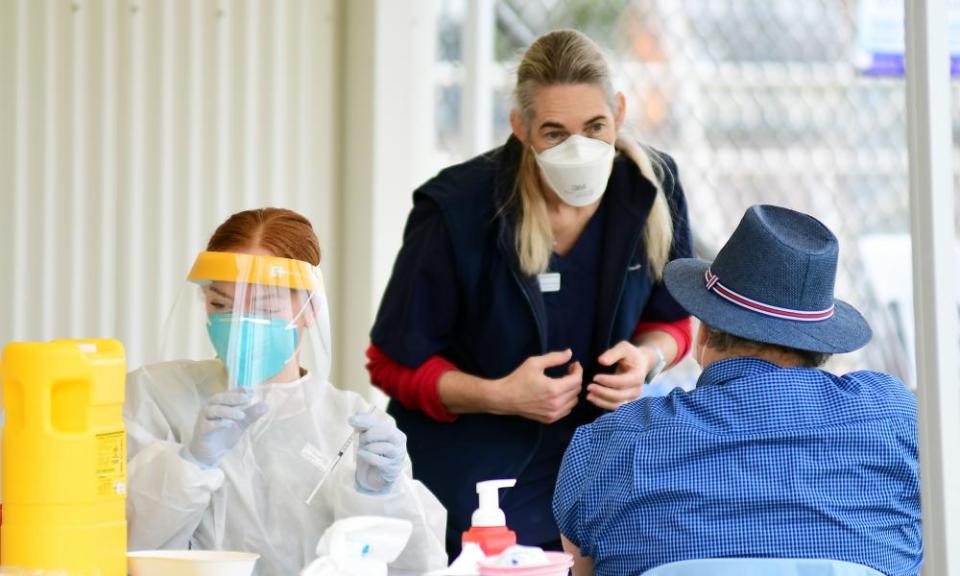Growing Covid clusters in regional NSW spark concerns ahead of long-awaited reopening

Covid clusters are continuing to grow in some regional areas of New South Wales, particularly in the Hunter New England and Murrumbidgee LGAs, ahead of the planned reopening of the state to people from greater Sydney on Monday.
Of the 293 new locally acquired Covid-19 cases reported on Thursday, more than half were in regional areas, and just over a quarter were in Hunter New England.
Regional NSW is bracing for a spike in Covid cases when Sydneysiders return but businesses say it’s worth it to bring an end to the economic pain brought on by lockdowns.
The resumption of travel between regional NSW and Sydney had been delayed twice due to lagging vaccination rates in certain regional and remote areas, after health authorities funnelled supplies into Sydney hotspots during the Delta outbreak.
Related: Fears for hospitals in regional NSW as Covid spreads beyond Sydney
Just 36% of regional local government areas had 80% double-vaccinated populations when the premier, Dominic Perrottet, pushed back the reopening date to 1 November earlier this month.
The vaccination rates in the regions had since picked up pace, but still lagged among Indigenous populations. Not a single LGA in regional NSW had surpassed 75% fully vaccinated rates among its Indigenous population, with figures as low as 52% in Richmond and 57% in the Mid North Coast.
On the border of Victoria, cases in Murrumbidgee had doubled in less than a week, with 30 cases recorded on Thursday, bringing the current cluster to 461.
Albury Wodonga Health was caring for 510 Covid cases including the wider border region with Victoria, which reports its cases separately. Seven of its 13 Covid beds were already in use.
Some 94.4% of Murrumbidgee’s eligible population had received a first dose, but the LGA was still lagging behind the state average for double doses. Some 81.9% of the population was fully vaccinated compared to 86% across the state.
The federal independent member for Indi, Helen Haines, said “urgent attention and resources” were needed to contain the outbreak as Albury and Wodonga reopened to both Melbourne and Sydney.
“We knew this was coming … yet it seems there has been no plan to make sure we have the resources we need to respond to outbreaks when they occur in regional places,” she said.
Albury Wodonga Health had repeatedly had to turn people away from testing centres before 9am after reaching capacity. The hospital had already wound back some non-core services to redirect staff to the outbreak, and made a formal request to convert a ward in its cancer centre to care for Covid patients.
“Regional health services are being left to respond without enough support from the major cities,” Haines said.
“The genie’s out of the bottle, and that’s before we’ve received visitors arriving from Sydney and Melbourne while we experience our largest outbreak. There’s a lot of anxiety amongst the community, and enormous pressure on our health service.”
The Rural Doctors Association of Australia expressed concerns only a “couple hundred” unvaccinated people would need to get sick to overwhelm regional hospitals’ capacity.
Haines said it was still the right move to open up, but urged state governments to “send the resources to do so”.
“Tourism businesses have been decimated by a lack of visitation. But ultimately, we need to have contingency for the experience in the regions, and that means making sure we’ve got the resources on the ground to open up,” she said.
“It’s starting to happen now, but it should have happened earlier.”
Email: sign up for our daily morning briefing newsletter
App: download the free app and never miss the biggest stories, or get our weekend edition for a curated selection of the week's best stories
Social: follow us on YouTube, Facebook, Instagram, Twitter or TikTok
Podcast: listen to our daily episodes on Apple Podcasts, Spotify or search "Full Story" in your favourite app
The federal MP for Hunter, Joel Fitzgibbon, said there were mixed views on opening up.
“There was some concern about the risks associated with the return of our Sydney visitors while vaccination rates locally remain relatively low, particularly amongst younger people who are prevalent in the hospitality sector.
“However, with vaccination rates growing quickly now most people, including me, will welcome our Sydney visitors back with open arms.”
Gregory Dore, an infectious diseases physician at Sydney’s St Vincent’s hospital, said while case increases in Albury, Kempsey and Newcastle were “concerning”, the outbreaks were not rapidly escalating and remained largely restricted to the under-30s age group.
“Enhanced testing and access to early community-based treatments for those with higher risk of hospitalisation are required,” he said.
“There’s a need for optimising vaccine coverage in all regions of NSW, but this can be undertaken in parallel to opening up regional travel.
“NSW regional travel has already been delayed, so further delays would provide additional impact on families and others wanting to reconnect.”
For small businesses, the delay had meant furthereconomic hardship.
When news broke the Australian Capital Territory would reopen to the south coast, the Batemans Bay Business and Tourism Chamber president, Dave Maclachlan, erected a sign at the bottom of the Clyde Mountain reading “Welcome back Canberra, we’ve missed you”.
Between the 2019 bushfires and Covid lockdowns, Maclachlan said the south coast had a “right flogging on a number of fronts” the past two summers.
“We’re a tourism-based economy down here, and mostly small business,” he said.
“At the same time, almost 40% of houses here are owned by people outside the shire … we have a big reliance on Canberra and greater Sydney. When they open up, it’ll be a huge game-changer.”
Maclachlan said there would always be nerves around reopening, but economically “a lot of small businesses couldn’t have gone on any longer”.
“People have gone to the wall and many won’t recover,” Maclachlan said.

 Yahoo Finance
Yahoo Finance 